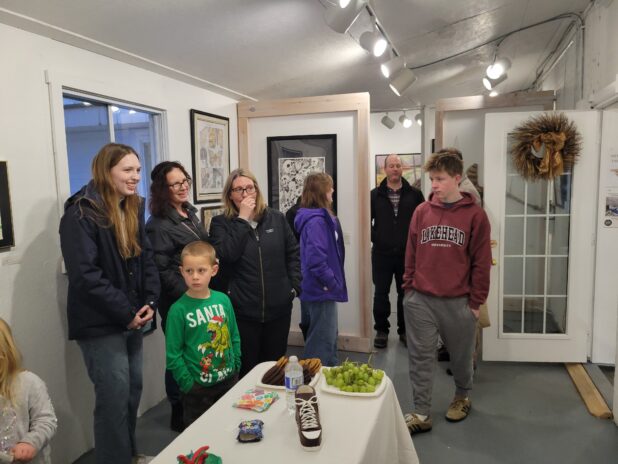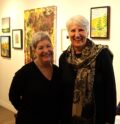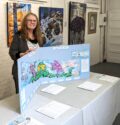Headline News
Students explore difficult topics in local exhibition
April 9, 2024

By Bill Kilpatrick
On Friday, April 5 the opening reception for the third annual North Hastings High School Student Art Show was held at A Place for the Arts. The non-juried exhibition showcased paintings, sketches, sculptures, and numerous other artworks created in multiple mediums that were fashioned over the past year by students from Grades 9 to 12. A Place for the Arts described the exhibition as “a diverse array of creativity and expression” full of “captivating artworks,” and the students did not disappoint. Their works covered topics that ranged from the destruction of the environment, beauty and death, sexism and stereotypes, social justice, the macabre, connectedness, love and fear, among many others. Bancroft This Week attended the opening reception and was able to speak with some of the students and the curator of the show, North Hastings High School educator and artist Andrew Edgar.
Edgar explained that shows like this are important for young aspiring artists to help build their confidence in not only showcasing their art but being able to speak to it as well. “I believe that showing your artwork is an important part of the creative experience,” said Edgar, “As a musician you’re thinking I’m gonna play this for somebody, and so as a visual artist you have to think about, Yes, I’m making this as a personal expression or as a class item, but the bigger picture is you’re making the work to show.” Edgar sees art as something that needs to be shared and appreciated otherwise it’s like a diamond in the mine, while it may be beautiful, it never reaches its full potential which can only be attained when it is exposed to light and where others can also appreciate it. “Art is meant to be seen,” explained Edgar, “you can create it in a classroom or you can create it in a studio but if you’re not putting it out there you’re creating in a bubble.”
Edgar acknowledged the deep connection between an artist and their art which is often an expression of something deeply personal, but he wants to encourage students to tell their stories through their art. “This is putting yourself out there,” he explained, “There are works on the wall here that are really personal and full of emotional rawness.” Another objective of Edgar’s is to have students be able to verbally articulate about their work, which he admits can be a struggle. “It’s one thing to make work, but to get students comfortable enough to talk to themselves or talk to each other about what they’re making is a separate thing that really needs to start to happen.” As an example, Edgar then looked at a student’s work and asked why they choose trees pointing out that “There was an assignment involved, but when it comes to the reality of subject matter, there’s choices made and there’s reasons for those choices.”
One student that did not have any difficulty discussing her work was Taylor Robinson who sold her first painting minutes before she was interviewed. Her piece was deeply personal and was entitled Under The Water? Which was an expression of one of her gravest fears as she explained, “I actually have a huge fear of deep water like the ocean itself, so I thought I’d try drawing it.” Her work shows a woman who had just fallen into the water looking helpless who appears to be getting pulled down by the weeds, but is unable or unwilling to resist. The expression on the woman’s face appears to be one of both vulnerability, terror, and an odd acceptance. Taylor said that the bigger message is just a feeling “of drowning in general.”
Elizabeth Cox explored the intricacies of the human skeleton in her piece entitled Skulls. “It’s not morbid,” explained Elizabeth who spoke about why she chose skulls, “It’s mainly because they have so much definition to it, I thought it would be fun to draw.” Her work was reminiscent of sketches that you might see in a seventeenth century medical textbook, full of fine details. She pointed out that the work took her over three weeks to complete and as we were talking Edgar walked by and called her work “exceptional” because of its detail. Elizabeth’s work could be juxtaposed with another student’s work, Michaela Burke, who also used skulls and skeletons in her drawing entitled, Decaying Affection: Beauty in the Macabre that, according to the artist’s description, was less about the detail and more about using skulls as “macabre imagery” to “illuminate the enduring beauty of love, emphasizing that its essence remains untarnished even in the face of mortality.” Both artists used skulls and skeletons to very different effect.
Isabella Dupuis’ work, according to her artists description, explored “modern day sexism and the stereotypes placed upon us” in an attempt to transcend external differences while celebrating humanity as a whole. She explained in her description that her piece, “avoids all aspects of genitalia, replaced by body parts that men, women and people both hold, no matter how we identify. Because after all we are all human.”
While Edgar stated that he was struggling to get his students to express themselves about their art, what ever he is doing is clearly working, because not only can these students create some moving pieces of art, they are able to articulate both in the oral and written forms about their own artistic processes.
The show runs from April 3 to the 28 at A Place For the Arts and there is no fee to see the show.

















